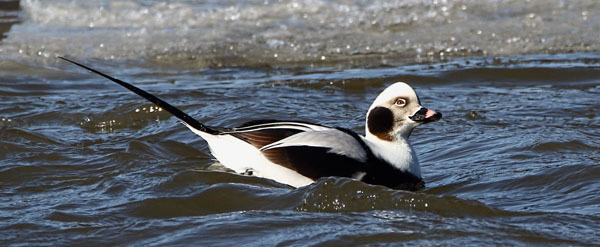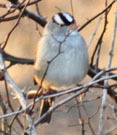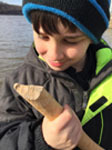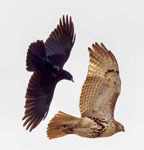Hudson River Almanac 1/5/19 - 1/11/19
The New York State Department of Environmental Conservation sent this bulletin on 01/18/2019 02:00 PM EST |
| DEC Delivers - Information to keep you connected and informed from the NYS Department of Environmental Conservation |
| Share or view as a web page || Update preferences or unsubscribe |
|
Compiled by Tom Lake, Hudson River Estuary Program Consulting NaturalistOverviewThis week we had a variety of unconnected natural history moments that highlight the broad range of Hudson River experiences, from birds to mammals to winter weather. Beachcombing, a favorite pastime of Hudson River shoreline visitors, provided a sweet and sour surprise. Highlight of the Week1/6 – Norrie Point, HRM 85: Three long-tailed ducks continued to swim in the river off the north tip of Esopus Island, about 600 yards offshore from the Norrie Point Environmental Education Center. [The long-tailed duck (Clangula hyemalis) is uncommon in the watershed and is seen primarily in seasonal migration. They breed in Arctic tundra pools, marshes, and in large mountain lakes and winter along the east coast of North America and on the Great Lakes. The former common name for long-tailed duck was oldsquaw. Although that name is still found in old field guides, it was dropped from common usage more than a decade ago in favor of long-tailed duck. This was done for several reasons, among which was the negative connotation of the English word and its offensive reference to Native Americans. Tom Lake] Natural History Entries
1/5 – Pine Island, HRM 46: In late afternoon, my daughter, Katie, noticed a big bird perched and watching our feeders. She said it looked like a blue jay – it had blue jay coloring, but it was bigger. I suggested it might be a “sparrow hawk.” Then, I saw the bird perched right in front of us, as we looked out the window with a backdrop of the setting sun. The bird was a raptor with blue-grey on his wings and head. It was a male American kestrel. This was the first time in 46 years of feeding birds that I ever had a kestrel visit. I knew he was not there for the seeds. He was there for the small birds or the mice attracted by the seeds. [American kestrels are one of three falcons that we see with regularity in the Hudson Valley. In the 1934 edition of the Roger Tory Peterson Field Guide to the Birds of Eastern North America, the kestrel, the smallest of our falcons, is referred to as the "sparrow hawk." Our mid-size falcon, the merlin, is called the "pigeon hawk." The largest of the three, the peregrine falcon, is referred to as the "duck hawk." Peterson offered these common names as a guide to each falcon's preferred prey size. Tom Lake] *** Fish of the Week ***
Brook trout, a native species, is the official New York State fish. They are quite easily recognized by their incredibly beautiful colors. Brook trout are considered to be a periglacial species in that they were among the first fishes to re-enter the watershed following the last Ice Age, an adaptation they retain preferring clear, cold, well-aerated water. While the New York State angling record is 6.0 pounds, from Silver Lake Wilderness Area, Hamilton County, those in the watershed are far smaller on average. In headwater streams of the Catskills and Adirondacks, confined by their micro-habitats, adult brook trout may be no more than five-inches-long. (Photo of brook trout courtesy of NYS Department of Environmental Conservation) 1/6 – Saugerties, HRM 102: Our 14th annual Esopus Bend Nature Preserve Winter Bird Count was conducted today. A field party surveying the 160-acre preserve for twelve hours recorded a total of 42 species (a record high number of species, surpassing our previous high counts of 40 in 2016 and 2009) and 583 individual birds. This also included 2.5 hours of nocturnal “owling" (two hours pre-dawn, one-half hour post-dusk). Our ten-year average for this count is 37 species and 514 individuals. Our highlight this year was a female-type common yellowthroat seen and heard very briefly in brushy habitat bordering the wetlands. Common ravens have become a regular year-round sighting in the skies over Esopus Bend Nature Preserve, but they have eluded us during the winter bird count until this year. Two ravens were simultaneously seen and heard flying over the Preserve, and a possible third individual was observed overhead, later in the day harassing a Black Vulture. This new addition to the count composite advances our historical total to 68 species. 1/6 – Fishkill, HRM 62: I was stopped at a store this morning when a huge dark cloud started dropping snow pellets. They were big and something looked odd about them – they were all perfectly conical – so I scooped some up. I later discovered that what I was calling “snow-hail,” was actually called graupel. [Graupel, also called soft hail, or snow pellets, is precipitation that forms when super-cooled water droplets are collected and freeze on falling snowflakes, forming small balls of rime. Tom Lake] 1/6 – South Salem, HRM 44: Amidst snow flurries on November 11, I reported seeing a female ruby-throated hummingbird at my neighbor’s feeder. The hummingbird was still around today. My neighbor keeps feeding it and making sure that the nectar bottle doesn't freeze. 1/6 – Bergen County, NJ.12: I spotted the first blooming snowdrops of 2019 this morning along the Hudson River Greenway where the trail ascends from the river's edge just north of the George Washington Bridge. 1/7 – Saratoga County, HRM 182: What a difference a day makes. Yesterday, Saratoga Lake had at least 75% open water. This afternoon, that percentage had fallen to 40%. With single digit air temperatures predicted later in the week, the open water will shrink even more. The north and south ends were mostly frozen, and it was now-or-April for seeing waterfowl on Saratoga Lake. The largest concentration of birds was off the condominium community of Water's Edge. Common mergansers were high count with about 700 birds, 90% of which were drakes. A pair of canvasbacks were in with the mergansers.
1/9 – Columbia County, HRM 113: I was riding on a town road two days ago in the Town of Greenport, and out of the corner of my eye, I noticed an avian predator hitting the ground pursuing prey. I turned around to see what it was and expected to find a red-tailed hawk, but I was surprised to see a short-eared owl. Today, while riding on a nearby town road, I spotted another short-eared owl perched in a red cedar. I wondered if it was the same owl.
[The beaver (Castor canadensis) is New York State's official mammal. They were an important part of the Hudson Valley Native American economy for food and fur. In Colonial times, Europeans incited “beaver wars” among native tribes, and by the 19th century, beaver were nearly extirpated from the watershed. Restocking and their amazing ability to adapt to a changing ecology have resulted in their restoration. Beaver sticks are a feature of almost any walk along a tidewater beach on the Hudson River. These are gnawed pieces of poplar, maple, birch or other deciduous trees. The sticks have a whittled, tapered end and range in size from six-inches to six-feet in length. The shaft often has rows of tiny toothmarks, like an ear of corn that has been nibbled. They are often the product of a dam-building exercise or even just a beaver snack. Having striped off the leaves, tender twigs, and even the bark, they are cast adrift in ponds, lakes, and streams with an outlet to the river. They find their way down the watershed and are finally cast up on a beach through wind, tide and current. Those of us who find beaver sticks, see them like a postcard from old friend. Tom Lake] 1/10 – Saratoga Lake, HRM 182: The Thursday birders took a last trip around Saratoga Lake before “real winter” arrived. Some of the lake was ice-free, but it didn't look promising when we started out from Brown's Beach with just a hundred common mergansers, the first of many to come. From Silver Beach, we caught a look at two white-winged scoters as we made our way north, adding a few thousand Canada geese (and one snow goose) and perhaps a thousand common mergansers. At the boardwalk at the Water's Edge condos, we hit the jackpot. Ron Harrower's flock of canvasbacks (see 1/7) was up to nine birds, along with two drake northern pintails, a “blue phase” snow goose, and many bufflehead. Best sighting of the day was a cackling goose, seen briefly before disappearing into a throng of Canada geese.
1/10 – Beacon, HRM 61: It was a far different tableau today than we faced yesterday at Kowawese. A gusty (35 mph) north wind coupled with an air temperature of 25 degrees F, had the windchill of -10 degrees F. Two days of strong winds had pushed the river toward the sea, and we could almost see the ebb tide slipping down the beach. Although we were in the lee of the point, the wind stung our faces. A dozen Canada geese chose the beach for refuge rather than negotiate the raucous river. Gulls flying past were tacking in the wind like schooners; most of the time they appeared to be flying backwards. [Windward and leeward are terms that are often used to provide color and accuracy to the description of a location or condition under which a sighting was made. These are sailing terms used to denote wind exposure: windward being in the face of the wind; leeward meaning sheltered, as in the lee of a point, an island, or a stand of trees. Tom Lake] 1/10 - Manhattan, HRM 1: Traditionally, January is a slow month for active river life. As a result, with few expectations, we checked our research sampling gear in Hudson River Park at The River Project's sampling station on the lighthouse tender Lilac at Pier 25. While we caught no fish in our pots and traps, we did find several dozen shore shrimp (Palaemonetes sp.), isopods, and a couple of blue mussels (Mytilus edulis). 1/11 – Minerva, HRM 284: The sun was down and darkness had taken over the foothills of the Adirondacks. It was zero (0) degrees F outside. Our “back forty” pond was frozen over. Winter was here. 1/11 – Warren County, HRM 245: I passed by the Ice Meadows along the Hudson River just south of The Glen today. The river was not yet clogged with the huge ice blocks that define the Ice Meadows. I figure just a few more days and we will see some frazil ice out there. [Frazil ice first forms as tiny round crystals – after nucleating in some way that has long been a puzzle to scientists – throughout the river in cold weather. Turbulent super-cooled (slightly below 32 degrees F) water tumbles the crystals around making them grow until they float at the surface in loose agglomerations. It looks like floating snow. If frazil touches something underwater, a deadfall or a rock, it sticks. It builds from the sides and from the middle of the river and can eventually form dams, such is the case at the Ice Meadows where the ice can grow to near glacial proportions. Cobbles and gravels at the bottom can be popped to the surface when the ice becomes buoyant enough. This process adds to the other river dynamics that are constantly moving sand, silt, gravel, and cobbles along the riverbed. Evelyn Greene]
[The cackling goose (Branta hutchinsii) is a smaller version of the Canada goose. It was formerly considered the smallest subspecies of one variable species, but recent work on genetic differences found the four smallest forms to be very different. These four races are now recognized as a full species: the cackling goose. It breeds farther northward and westward than does the Canada goose. Cornell Lab of Ornithology] Winter 2018 Natural History ProgramsAmphibian Migrations & Road Crossings (AM&RC) Volunteer Training The Hudson River Estuary Program is hosting an optional Amphibian Migrations & Road Crossings (AM&RC) Volunteer Training that will be helpful for new volunteers, as well as anyone needing to refresh or refine their skills. We will review amphibian identification and provide volunteer guidance on AM&RC data collection methods and safety measures. There will also be a hands-on activity and a chance to meet other volunteers. The workshop is free. However, space is limited, and registration is required. To sign up, please use this link: https://www.surveymonkey.com/r/AMRC_2019_VolunteerTraining Hudson River MilesThe Hudson is measured north from Hudson River Mile 0 at the Battery at the southern tip of Manhattan. The George Washington Bridge is at HRM 12, the Tappan Zee 28, Bear Mountain 47, Beacon-Newburgh 62, Mid-Hudson 75, Kingston-Rhinecliff 95, Rip Van Winkle 114, and the Federal Dam at Troy, the head of tidewater, at 153. The tidal section of the Hudson constitutes a bit less than half the total distance – 315 miles – from Lake Tear of the Clouds to the Battery. Entries from points east and west in the watershed reference the corresponding river mile on the mainstem. To Contribute Your Observations or to SubscribeThe Hudson River Almanac is compiled and edited by Tom Lake and emailed weekly by DEC's Hudson River Estuary Program. Share your observations by e-mailing them to trlake7@aol.com.
National Oceanic and Atmospheric Administration online tide and tidal current predictions are invaluable when planning Hudson River field trips. |

 Hudson River Almanac
Hudson River Almanac 1/5 – Washington County, HRM 209: I had a nice sunny afternoon in the Washington County Grasslands Wildlife Management Area. Highlights included a single white-crowned sparrow amidst a plethora of American tree sparrows on Towpath Road in Kingsbury. (Photo of white-crowned sparrow courtesy of Scott Varney)
1/5 – Washington County, HRM 209: I had a nice sunny afternoon in the Washington County Grasslands Wildlife Management Area. Highlights included a single white-crowned sparrow amidst a plethora of American tree sparrows on Towpath Road in Kingsbury. (Photo of white-crowned sparrow courtesy of Scott Varney) 1/5 – Hudson Valley Estuary: This week’s selection is the brook trout (Salvelinus fontinalis), species number 97 (out of 228) on our watershed list of fishes.
1/5 – Hudson Valley Estuary: This week’s selection is the brook trout (Salvelinus fontinalis), species number 97 (out of 228) on our watershed list of fishes. 1/8 – Eastern Dutchess County, HRM 96: We pulled into the Stissing House Restaurant this afternoon and found three dumpster-diving black vultures that appeared to be comfortable with our presence. They eventually flew from the dumpster to a near-by puddle for a drink to wash down their lunch. (Photo of black vulture courtesy of Phil Margiotta)
1/8 – Eastern Dutchess County, HRM 96: We pulled into the Stissing House Restaurant this afternoon and found three dumpster-diving black vultures that appeared to be comfortable with our presence. They eventually flew from the dumpster to a near-by puddle for a drink to wash down their lunch. (Photo of black vulture courtesy of Phil Margiotta) 1/9 – Town of Poughkeepsie: The adult pair of eagles at Bald Eagle nest NY62 were fully into their pre-breeding season routine. They were perched this afternoon on a horizontal branch amidst the flower buds of their tulip-nest-tree touching wings. Although their expression never changes, they had some bounce in their step and seemed generally pleased. (Photo of mated pair of bald eagles at NY62 courtesy of Bob Rightmyer)
1/9 – Town of Poughkeepsie: The adult pair of eagles at Bald Eagle nest NY62 were fully into their pre-breeding season routine. They were perched this afternoon on a horizontal branch amidst the flower buds of their tulip-nest-tree touching wings. Although their expression never changes, they had some bounce in their step and seemed generally pleased. (Photo of mated pair of bald eagles at NY62 courtesy of Bob Rightmyer) 1/9 – Kowawese, HRM 59: Being in the lee of a hillside, the strong northwest wind could not reach us. The flood tide had deposited an acre of flotsam high on the beach. Looking through it – beach-combing – gave us a glimpse of our impact on our world. There was all manner of plastics and human refuse. Among the organics were “beaver sticks” – we counted fourteen without really trying. The water was 35 degrees Fahrenheit (F); ice would soon be here. The salinity was unmeasurable. (Photo of beaver stick courtesy of Tom Lake)
1/9 – Kowawese, HRM 59: Being in the lee of a hillside, the strong northwest wind could not reach us. The flood tide had deposited an acre of flotsam high on the beach. Looking through it – beach-combing – gave us a glimpse of our impact on our world. There was all manner of plastics and human refuse. Among the organics were “beaver sticks” – we counted fourteen without really trying. The water was 35 degrees Fahrenheit (F); ice would soon be here. The salinity was unmeasurable. (Photo of beaver stick courtesy of Tom Lake) 1/10 – Town of Poughkeepsie: There was an amazing clash of strong-willed birds in mid-afternoon along the Hudson River off Bowdoin Park. A common raven met an adult red-tailed hawk head-on, and a contention for airspace ensued. The red-tail was from a local pair that nest in a tall red oak up on an escarpment overlooking the river. The raven may have simply been passing. They dueled for a minute or so and then broke off before it became serious. (Raven vs. red-tailed hawk courtesy of Bob Rightmyer)
1/10 – Town of Poughkeepsie: There was an amazing clash of strong-willed birds in mid-afternoon along the Hudson River off Bowdoin Park. A common raven met an adult red-tailed hawk head-on, and a contention for airspace ensued. The red-tail was from a local pair that nest in a tall red oak up on an escarpment overlooking the river. The raven may have simply been passing. They dueled for a minute or so and then broke off before it became serious. (Raven vs. red-tailed hawk courtesy of Bob Rightmyer) 1/11 – Albany, HRM 145: During my morning walk on the Corning Preserve, I came upon a cackling goose (Branta hutchinsii) among a small flock of Canada geese. (Photo of cackling goose courtesy of Cassie Davis)
1/11 – Albany, HRM 145: During my morning walk on the Corning Preserve, I came upon a cackling goose (Branta hutchinsii) among a small flock of Canada geese. (Photo of cackling goose courtesy of Cassie Davis)